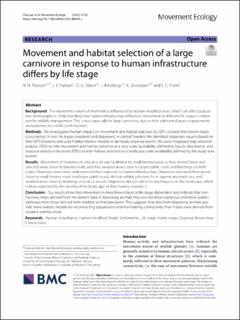| dc.contributor.author | Thorsen, Neri Horntvedt | |
| dc.contributor.author | Hansen, Jennifer Eve | |
| dc.contributor.author | Støen, Ole-Gunnar | |
| dc.contributor.author | Kindberg, Jonas | |
| dc.contributor.author | Zedrosser, Andreas | |
| dc.contributor.author | Frank, Shane | |
| dc.date.accessioned | 2023-02-15T11:26:43Z | |
| dc.date.available | 2023-02-15T11:26:43Z | |
| dc.date.created | 2022-12-13T12:36:08Z | |
| dc.date.issued | 2022 | |
| dc.identifier.citation | Thorsen, N. H., Hansen, J. E., Støen, O. G., Kindberg, J., Zedrosser, A. & Frank, S. C. (2022). Movement and habitat selection of a large carnivore in response to human infrastructure differs by life stage. Movement Ecology, 10, Artikkel 52. | en_US |
| dc.identifier.issn | 2051-3933 | |
| dc.identifier.uri | https://hdl.handle.net/11250/3051038 | |
| dc.description.abstract | Background: The movement extent of mammals is influenced by human-modified areas, which can affect population demographics. Understanding how human infrastructure influences movement at different life stages is important for wildlife management. This is true especially for large carnivores, due to their substantial space requirements and potential for conflict with humans.
Methods: We investigated human impact on movement and habitat selection by GPS-collared male brown bears (Ursus arctos) in two life stages (residents and dispersers) in central Sweden. We identified dispersers visually based on their GPS locations and used hidden Markov models to delineate dispersal events. We used integrated step selection analysis (iSSA) to infer movement and habitat selection at a local scale (availability defined by hourly relocations), and resource selection functions (RSFs) to infer habitat selection at a landscape scale (availability defined by the study area extent).
Results: Movement of residents on a local scale was facilitated by small forestry roads as they moved faster and selected areas closer to forestry roads, and they avoided areas closer to larger public roads and buildings on both scales. Dispersers were more ambivalent in their response to human infrastructure. Dispersers increased their speed closer to small forestry roads and larger public roads, did not exhibit selection for or against any road class, and avoided areas closer to buildings only at local scale. Dispersers did not select for any features on the landscape, which is likely explained by the novelty of the landscape or their naivety towards it.
Conclusion: Our results show that movement in male brown bears is life stage-dependent and indicate that connectivity maps derived from movement data of dispersing animals may provide more numerous and more realistic pathways than those derived from resident animal data alone. This suggests that data from dispersing animals provide more realistic models for reconnecting populations and maintaining connectivity than if data were derived from resident animals alone. | en_US |
| dc.language.iso | eng | en_US |
| dc.rights | Navngivelse 4.0 Internasjonal | * |
| dc.rights.uri | http://creativecommons.org/licenses/by/4.0/deed.no | * |
| dc.title | Movement and habitat selection of a large carnivore in response to human infrastructure differs by life stage | en_US |
| dc.type | Peer reviewed | en_US |
| dc.type | Journal article | en_US |
| dc.description.version | publishedVersion | en_US |
| dc.rights.holder | © The Author(s) 2022. | en_US |
| dc.source.pagenumber | 14 | en_US |
| dc.source.volume | 10 | en_US |
| dc.source.journal | Movement Ecology | en_US |
| dc.identifier.doi | https://doi.org/10.1186/s40462-022-00349-y | |
| dc.identifier.cristin | 2092523 | |
| dc.source.articlenumber | 52 | en_US |
| cristin.ispublished | true | |
| cristin.fulltext | original | |
| cristin.qualitycode | 1 | |

